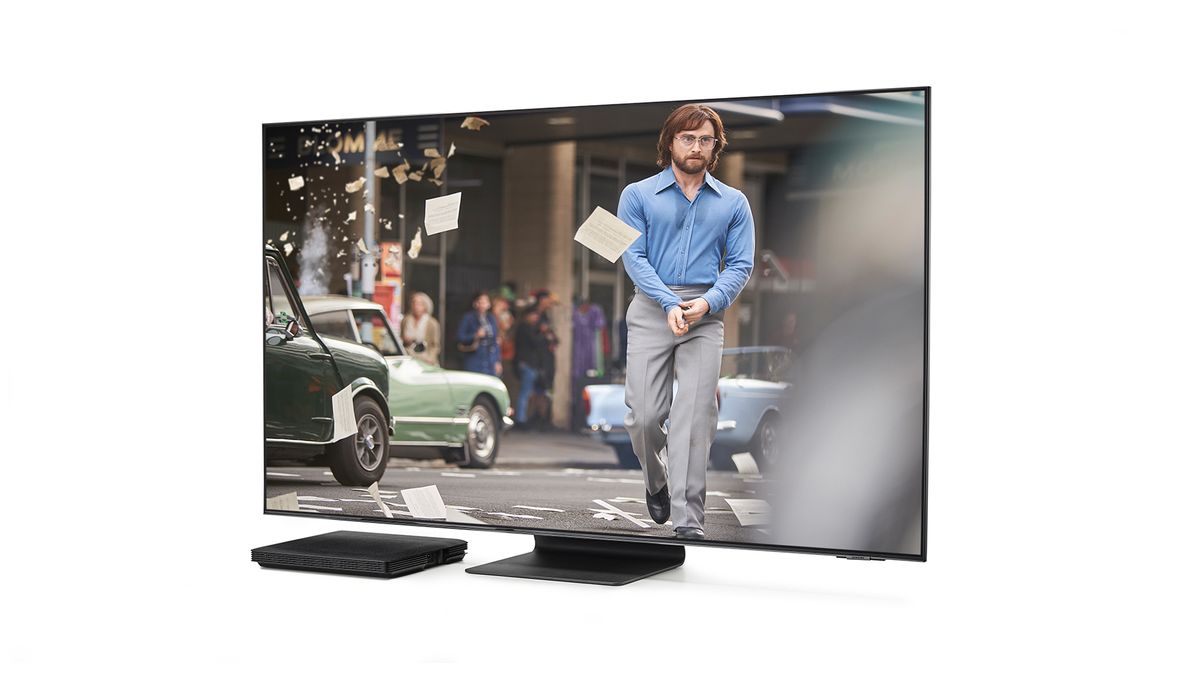What Hi-Fi? Verdict
Samsung’s first Neo QLED is a force to be reckoned with, and the greatest threat yet to the dominance of OLED
Pros
- +
Superbly bright, punchy and sharp
- +
Exhaustive feature set
- +
Lovely design
Cons
- -
Artificial boost to dark detail
- -
Reticence with extreme contrast
- -
Still no Dolby Vision
Why you can trust What Hi-Fi?
This year looks very much like the year of Mini LED. The technology, which sees the traditional LEDs of a TV backlight miniaturised in order to increase contrast, is a feature of the 2021 line-ups of most major TV brands, including LG and Philips.
For those brands, Mini LED TVs sit below their OLED models, but for Samsung, Mini LED is its flagship technology (assuming you discount its eye-wateringly expensive new Micro LED sets). The company has developed its own Mini LEDs, which it says are even smaller and more efficient than those of its rivals, and combined them with its existing Quantum Dot tech to create a range of premium TVs that it calls Neo QLEDs.
The QE65QN95A is the first Neo QLED we've tested. It’s the top 4K model in Samsung’s 2021 range, and it purports to offer a huge upgrade on last year’s equivalent without any increase in price.
This is the model that Samsung is pitching against LG’s incredibly popular C-class OLED, the 2021 version of which (the C1) we have yet to review. When it does appear, the C1 is going to have its work cut out because the Samsung QN95A is the best QLED there’s ever been, and that makes it a serious challenger to even the best OLEDs.
Pricing
The Samsung QE65QN95A is priced at £2999 – exactly the same price its predecessor, the QE65Q95T, launched at, despite this new model representing what appears to be a serious technological upgrade.
The QN95A is exclusive to Europe. US buyers instead get the QN90A, which does without the QN95A’s One Connect box and has just one HDMI 2.1 socket (the QN95A has four). Confusingly, the US QN90A is different to the European QN90A, which is more heavily downgraded. Apparently, Europe will in fact get an as-yet-unannounced model called the QN94A, which will be the same as the US’s QN90A.
If you've completely lost track, it’s no surprise. It feels as though Samsung has gone out of its way to make its model structure even less coherent than it was in 2020. Sony, meanwhile, is putting a concerted effort into unifying its model numbers across all regions, and LG has been doing that for years, at least in terms of its OLEDs.
Build
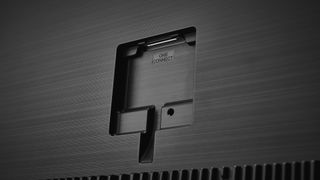
Besides the benefits in terms of contrast, a Mini LED backlight is much slimmer than one consisting of standard LEDs. Samsung has also worked hard to reduce the distance between the backlight and the Quantum Dot panel, making the whole display section slimmer.
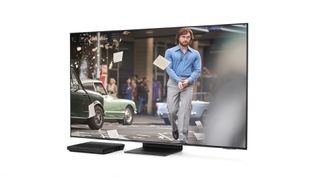
Screen type QLED
Backlight Mini LED
Resolution 4K
Operating system Samsung Tizen
HDR formats HDR10, HDR10+, HLG
HDMI x4
USB x3
Optical x1
Of course, a TV also needs to pack in processing hardware and speakers, but Samsung has still managed to reduce the thickness of the QN95A to just 2.6cm, down from the 3.5cm of last year’s Q95T.
That doesn’t make the QN95A as thin as an OLED is at its thinnest point (the LG CX is under 4mm thick here) but its uniform depth measurement means it is much thinner than most OLEDs are at their thickest points (the CX is 4.7cm here) and arguably makes for a more stylish, picture frame-like proposition when wall mounted.
The QN95A also gets the new, redesigned version of Samsung’s One Connect box. The concept is the same – all connections, including power, go into a separate unit that’s connected to the TV via a single cable – but the chunky brick design has been replaced by one reminiscent of a stack of five or six placemats. While this One Connect can be mounted to the rear of the stand of Samsung’s 2021 8K models, it can’t be mounted to the QN95A at all.
Also slightly disappointing is that the cable that runs between the One Connect box and display is significantly thicker and less flexible than that of previous versions. Samsung says the cable has changed in the name of “performance stability and durability”, but we weren’t aware of any issues with the previous design.
While the move to a thicker wire is a bit of a shame, having just one cable running to the display rather than multiple HDMIs and power is still undeniably neater. And, if your set-up means that the One Connect box will be visible in your TV rack, this new version is significantly easier on the eye than its predecessor.
Features
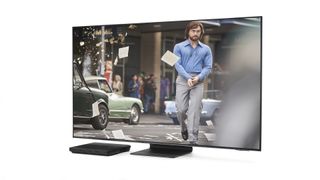
The One Connect box also gives the QN95A a more advanced set of connections than other 2021 Samsung models such as the QN94A. It’s all down to the HDMIs: all four of the QN95A’s HDMI sockets are 2.1-spec, while its siblings get just one HDMI 2.1 socket. That probably won’t make a huge difference right now, but anyone planning to buy both the PS5 and Xbox Series X will need more than one HDMI 2.1 socket to take full advantage of both consoles, and there will only be more HDMI 2.1 sources in the future.
Of course, simply having HDMI 2.1 sockets isn’t enough to guarantee support for all of those fancy next-gen HDMI features, but the QN95A offers support for eARC (Enhanced Audio Return Channel), ALLM (Auto Low Latency Mode), 4K@120Hz (aka High Frame Rate) and VRR (Variable Refresh Rate). VRR is supported in all three of the formats currently available: standard HDMI VRR, Nvidia G-Sync (Samsung is at pains to clarify that the TV is G-Sync-compatible rather than fully certified) and AMD FreeSync (this is the first TV to be FreeSync Premium Pro-certified, in fact).
As is probably already clear, Samsung is even more committed to courting gamers than before, going as far as creating the 'Game Bar' – a pop-up menu that gives you quick access to various game-related features and delivers live information on the signal being received, including the VRR format and frame rate. Input lag, meanwhile, has been reduced to under 10ms, which is entirely imperceptible. If you don’t mind sacrificing a little of that speed, you can enable some gaming-specific motion smoothing, although we don’t find that necessary during testing.
Finally, on the gaming front, the HGiG (HDR Gaming Interest Group) setting that was added to Samsung’s 2020 QLEDs via a software update late last year is also present on the QN95A. This is well worth using in conjunction with your console’s HDR calibration settings as it results in a more accurate picture with deeper blacks and more detailed highlights.
Samsung has also long been the market leader when it comes to integrated streaming apps, and the QN95A is just as well-appointed as its predecessors in that regard. Netflix, Amazon Prime Video, Disney+, Apple TV, Google Play Movies & TV and Rakuten are all present in 4K and HDR; BBC iPlayer, ITV Hub, All 4 and My5 complete the set of catch-up apps; Now TV and BT Sport are also here; and Spotify, Tidal, Apple Music, Amazon Music, Deezer, BBC Sounds and TuneIn mean every major music and radio app is on board, too. In short, there’s no app of significance that’s missing here, and there are loads of niche apps in there too.
There is, though, an HDR format of significance that's missing – Dolby Vision. While Samsung's rival HDR10+ has made undeniable in-roads in recent years, Dolby Vision is clearly the more dominant format and it's very hard indeed to see the power balance shifting. Even if Samsung truly believes HDR10+ is better, it should by now be offering Dolby Vision support as well.
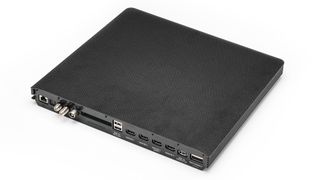
The operating system is more or less unchanged from last year, which is no bad thing. It’s still the best in the business, slickly getting you to the content you’re after quicker than any rival. One new feature that has the potential to be great is Multi View, which allows you to split the screen in two and watch an HDMI source in one window while you access an app via the other. We could see this could be useful for watching two football games at once, for example, one via your Sky Q box and the other the BT Sport app, but currently the only apps supported in Multi View are YouTube and a wellness app called Calm, rendering it almost useless.
The QN95A’s new remote has a useful new feature, though: on the bottom is a light panel that allows it to be charged via sunlight and even house lights. It works really well – during testing, the remote’s battery level doesn’t drop below about 95 per cent as it constantly tops itself up. That said, the remote does also have a USB-C socket that can be used as a backup charging method.
Under the TV’s skin is a new version of Samsung Quantum Processor, called the Neo Quantum Processor 4K. The big new feature here is referred to as Ultra Precision Light Driving, which involves more precise dimming and a local power distribution feature that sends power to the brightest areas of the picture and away from the darker parts. It also works in conjunction with a sensor integrated into the TV's frame to adjust brightness and contrast in response to ambient lighting conditions. There’s a new level of ‘deep learning’ applied to contrast enhancement, too.
Of course, the biggest new feature of the QN95A is its Mini LED backlight. Samsung explains that the majority of a typical LED's size is made up of its protective packaging and light-guiding lens, both of which it has done away with for its so-called 'New LEDs'. Not only that, but it has also miniaturised the LEDs themselves, to astonishing effect: the new LEDs, packaging and all, are a fortieth the size of their traditional counterparts and look like little more than sparkly grains of sand.
Instead of a lens, this New LED backlight works with a new 'micro layer' that guides the light through the quantum dots (which provide the set's colours). The result is apparently no light leakage or blooming.
Crucially, because the New LEDs are so much smaller, significantly more of them can be packed in, creating more individual dimming zones in the process. While Samsung doesn’t quote official figures for these dimming zones, we understand that the QN95A has just under 800 of them. Last year’s Q95T and Q90T are thought to have had around 120 dimming zones each so, on paper at least, this appears to be a massive upgrade that should have a startling impact on contrast.
Picture
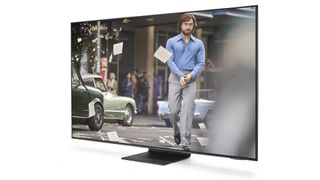
Kicking off with the 4K Blu-ray of John Wick: Chapter 3, it quickly becomes clear that this is a massive upgrade in real terms, too. Not only does the QN95A go vastly brighter than the OLED competition, in most conditions it combines bright and dark picture elements unlike any commercially available TV before it. As John cuts through the chandelier shop near the start of the film, the warm, piercing light contrasts brilliantly with the rain-soaked streets in the background, with the bulbs and the glass sections of the chandeliers sparkling to a degree that makes the Award-winning Philips 65OLED805 look decidedly dull.
Crucially, this brightness doesn’t come at the expense of black depth, which is close to OLED-quality. If you look closely at a still image, you can see that the top black bar loses a bit of purity as one of the shining bulbs lingers at its edge, but in action, this isn’t noticeable. What’s more, there’s no obvious haloing around bright objects on dark backgrounds, or any other real hint that this is a backlit telly. It’s not totally perfect, but it could be argued that it’s close enough to not matter.
That said, the QN95A is, like its predecessor, a little cautious when confronted by small bright objects in otherwise overwhelmingly black images. During the opening scene of It, Pennywise’s eyes should glow menacingly bright out of the gloom of the basement, but they’re barely noticeable here. As the camera heads through the tunnel towards daylight for the start of the film, it’s clear that the TV is holding back, presumably for fear of introducing blooming, and it makes the image less exciting than it should be.
The same trait is clear in the company logos and intro text at the start of Blade Runner 2049. It could be that Samsung is playing things just a little too safe here, but crucially, these ultra-high contrast images are relatively uncommon, and in isolation, the Samsung’s delivery rarely looks wrong. It’s only in a side-by-side comparison with one of the punchier 2020 OLEDs that this reticence becomes clear.
The only other slight flaw in the QN95A’s delivery is regarding the balance of dark detail and black depth. Not that the TV isn’t capable of both, but we struggle to find the perfect balance. There’s a dedicated Shadow Detail setting that does exactly that but it also somewhat washes out the image. Switching the Contrast Enhancer to High, meanwhile, reveals so much dark detail that it feels as though artificial light is being added to some dark scenes.
We’ve always appreciated Samsung’s bold and straightforward picture settings, but for this TV, a Contrast Enhancer setting between Low and High might have proved perfect. As it is, you have to trade just a bit of dark detail to get inky blacks, or have slightly artificially boosted shadow detail.
Ultimately, though, the QN95A is a stunning performer overall. It’s so dynamic and vibrant that it makes its rivals look flat and boring. Whites, in particular, are incredibly pure and punchy, from John Wick’s shirt to the fluorescent lights hanging from the ceiling of the first-floor armoury above the chandelier shop.
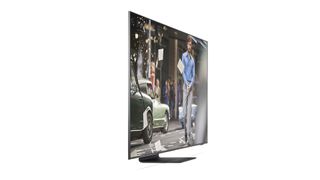
Colours are incredibly lush, too, but also natural and controlled – as long as you tone down the Colour setting just a bit. It’s the perfect foil for the comic book-style exaggeration of John Wick 3, pumping up the pink of the shirts of the call centre staff and bringing the Marrakesh market to life with its varied and vibrant hues.
Switch to 1917 and the vibrancy is tempered by a slightly unexpected degree of naturalism. Some TVs we’ve reviewed have, in their quest for vibrancy, pushed the green fields at the film’s start from verdant to lurid, but the QN95A doesn’t fall into this trap and the film is delivered with both punch and poise.
The same effortless balance is applied in regards to detail and sharpness, too. Where some TVs, including previous Samsung models, can over-sharpen edges and details, giving everything an artificially etched look, the QN95A ensures that everything is crisp and clearly defined without any of that exaggeration. The detail is all there, but it isn’t rammed down your throat, and that’s the way it should be.
In 2020, Samsung took a big step forward in terms of motion processing, and it’s good to see that that balance of smoothness and naturalism continues into 2021. Again, you need to select the right setting: the default Auto setting is forced and unpleasant, but switching to Custom and setting Blur Reduction and Judder Reduction to 10 and 3 respectively keeps motion controlled without adding fizz around fast movement or any of the dreaded soap opera effect.
Switching from 4K to 1080p with the Looper Blu-ray, it becomes clear that this Samsung takes a surprisingly subtle approach to SDR content. While many TVs attempt to give SDR content an HDR sheen, the QN95A opts instead for subtlety. Compared with the Philips OLED805, the Samsung’s image is less dynamic and instantly exciting, but also more nuanced in its shading and a fair bit more detailed. Both approaches have their merits, but Samsung’s feels more authentic.
The same relative characteristics are present as we switch to our trusty Dirty Harry DVD. While the Samsung is once again less punchy in its delivery, it’s subtler and cleaner, too.
Sound
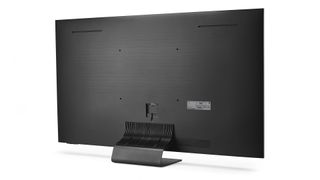
Considering the QN95A’s sound system is essentially invisible, it packs in a large number of drivers – eight of them, in fact – in a 4.2.2 arrangement that Samsung refers to as OTS+ and is rated to 70W. ‘OTS’ stands for ‘Object Tracking Sound’ and refers to the fact that the system is designed to create a sense of three-dimensionality akin to Dolby Atmos. All of which makes it slightly baffling that the QN95A can’t natively play Dolby Atmos soundtracks, although it can pass them out to a connected speaker system (even a Samsung soundbar).
Regardless of the tech involved (or not), the QN95A puts in a solid audio performance that’s clear, direct and punchy but with good weight and openness. It delivers a strong sense of space and atmosphere while ensuring that dialogue and effects are presented clearly. Detail levels are high by the standards of an integrated sound system, too.
That said, the QN95A’s speakers struggle with the super-deep bass at the start of chapter 2 of Blade Runner 2049, with its woofers flapping uncomfortably. This is far from the only TV to have problems here – LG’s CX OLEDs suffer at least as badly – but it’s a shame all the same. Still, we would always recommend partnering a TV as impressive as this with a dedicated sound system, and this flaw only reinforces that message.
If you are determined to stick with the Samsung’s integrated speakers, Adaptive Volume is best switched off as it tends to sound quite forced and hard, but Adaptive Sound+ is worth using as it adds spaciousness and a slight sense of cinematic envelopment. Amplify is worth trying, too: it sacrifices a bit of low-level dynamic subtlety for bigger overall dynamics and more punch, making it useful for action films. Standard is probably better if you want to use one setting for all content, though.
Verdict
While Mini LED might not quite be the revolution that Samsung is pitching it as, it’s still a substantial upgrade to an already excellent range of TVs. The overall contrast offered is staggering, and the QN95A combines near-OLED black levels with awesomely crisp white highlights and fabulously vibrant colours, all while retaining an effortless sense of naturalism.
Throw in the best, most app-packed operating system in the business, a delightfully slim design and a full set of next-gen HDMI sockets and this is (a lack of Dolby Vision support aside) as complete a package as can be imagined.
It’s early days for 2021 TVs, but Samsung has thrown down the gauntlet in emphatic style and it will be fascinating to see how its rivals respond.
SCORES
- Picture 5
- Sound 4
- Features 5
MORE:
Read our guide to the best TVs
Read our Philips 65OLED805 review
Read our Samsung QE65Q95T review
Read our LG OLED65CX review
What Hi-Fi?, founded in 1976, is the world's leading independent guide to buying and owning hi-fi and home entertainment products. Our comprehensive tests help you buy the very best for your money, with our advice sections giving you step-by-step information on how to get even more from your music and movies. Everything is tested by our dedicated team of in-house reviewers in our custom-built test rooms in London, Reading and Bath. Our coveted five-star rating and Awards are recognised all over the world as the ultimate seal of approval, so you can buy with absolute confidence.
